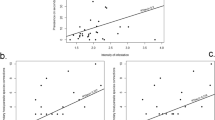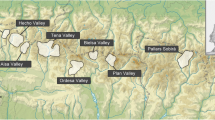Abstract
Ectoparasites of vertebrates often spend part of their life cycle in their hosts’ home. Consequently, hosts should take into account the parasite infestation of a site when selecting where to live. In a field study, we investigated whether colonial female Bechstein’s bats (Myotis bechsteinii) adapt their roosting behaviour to the life cycle of the bat fly Basilia nana in order to decrease their contact with infective stages of this parasite. B. nana imagoes live permanently on the bat’s body but deposit puparia in the bat’s roosts. The flies metamorphose independently in the roosts, but after metamorphosis emerge only in the presence of a potential host. In a field experiment, the bats preferred non-contagious to contagious day-roosts and hence were able to detect either the parasite load of roosts or some correlate with infestation, such as bat droppings. In addition, 9 years of observational data on the natural roosting behaviour of female Bechstein’s bats indicate that the bats largely avoid re-occupying roosts when highly contagious puparia are likely to be present as a result of previous occupations of the roosts by the bat colony. Our results indicate that the females adapted their roosting behaviour to the age-dependent contagiousness (emergence probability) of the puparia. However, some infested roosts were re-occupied, which we assume was because these roosts provided advantages to the bats (e.g. a beneficial microclimate) that outweighed the negative effects associated with bat fly infestation. We suggest that roost selection in Bechstein’s bats is the outcome of a trade-off between the costs of parasite infestation and beneficial roost qualities.


Similar content being viewed by others
References
Bartonička T, Gaisler J (2007) Seasonal dynamics in the numbers of parasitic bugs (Heteroptera, Cimicidae): a possible cause of roost switching in bats (Chiroptera, Vespertilionidae). Parasitol Res 100:1323–1330
Butler JM, Roper TJ (1996) Ectoparasites and sett use in European badgers. Anim Behav 52:621–629
Christe P, Oppliger A, Richner H (1994) Ectoparasite affects choice and use of roost sites in the great tit, Parus major. Anim Behav 47:895–898
Duffy DC (1983) The ecology of tick parasitism on densely nesting Peruvian seabirds. Ecology 64:110–119
Hart BL (1994) Behavioral defence against parasites—interaction with parasite invasiveness. Parasitology 109:139–151
Hart BL (1997) Behavioural defence. In: Clayton DH, Moore J (eds) Host–parasite evolution: general principles and avian models. Oxford University Press, Oxford
Hausfater G, Meade BJ (1982) Alternation of sleeping grooves by yellow baboons (Papio cynocephalus) as a strategy for parasite avoidance. Primates 23:287–297
Kerth G (1998) Sozialverhalten und genetische Populationsstruktur bei der Bechsteinfledermaus (Myotis bechsteinii). Wissenschaft und Technik Verlag, Berlin
Kerth G, König B (1996) Transponder and an infrared-videocamera as methods in a field study on the social behaviour of Bechstein’s bats (Myotis bechsteini). Myotis 34:27–34
Kerth G, König B (1999) Fission, fusion and nonrandom associations in female Bechstein’s bats (Myotis bechsteinii). Behaviour 136:1187–1202
Kerth G, Morf L (2004) Behavioural and genetic data suggest that Bechstein’s bats predominantly mate outside the breeding habitat. Ethology 110:987–999
Kerth G, Reckardt K (2003) Information transfer about roosts in female Bechstein’s bats: an experimental field study. Proc R Soc Lond B 270:511–515
Kerth G, Mayer F, König B (2000) Mitochondrial DNA (mtDNA) reveals that female Bechstein’s bats live in closed societies. Mol Ecol 9:793–800
Kerth G, Weissmann K, König B (2001) Day roost selection in female Bechstein’s bats (Myotis bechsteinii): a field experiment to determine the influence of roost temperature. Oecologia 126:1–9
Kerth G, Safi K, König B (2002) Mean colony relatedness is a poor predictor of colony structure and female philopatry in the communally breeding Bechstein’s bat (Myotis bechsteinii). Behav Ecol Sociobiol 52:203–210
Kunz TH, Lumsden LF (2003) Ecology of cavity and foliage roosting bats. In: Kunz TH, Fenton MB (ed) Bat ecology. University of Chicago Press, Chicago
Lausen CL, Barclay RMR (2002) Roosting behaviour and roost selection of female big brown bats (Eptesicus fuscus) roosting in rock crevices in southeastern Alberta. Can J Zool Rev Can Zool 80:1069–1076
Lewis SE (1995) Roost fidelity of bats – a review. J Mammal 76:481–496
Lewis SE (1996) Low roost-site fidelity in pallid bats: associated factors and effect on group stability. Behav Ecol Sociobiol 39:335–344
Löhrl H (1953) Fledermaus-Fliegen. Nat Volk 83:182–185
Marshall AG (1981) The ecology of ectoparasitic insects. Academic Press, London
Møller AP (1993) Ectoparasites increase the cost of reproduction in their hosts. J Anim Ecol 62:309–322
Moore J (2002) Parasites and the behaviour of animals. Oxford University Press, Oxford
Oppliger A, Richner H, Christe P (1994) Effect of an ectoparasite on lay date, nest-site choice, desertion, and hatching success in the great tit (Parus-major). Behav Ecol 5:130–134
Pastoret PP, Griebel P, Hervè B, Govaerts A (1998) Handbook of vertebrate immunology. Academic Press, San Diego
Peinke DM, Brown CR (2005) Burrow utilization by springhares (Pedetes capensis) in the Eastern Cape, South Africa. Afr Zool 40:37–44
Reckardt K, Kerth G (2006) The reproductive success of the parasitic bat fly Basilia nana (Diptera: Nyctreibiidae) is affected by the low roost fidelity of its host, the Bechstein’s bat (Myotis bechsteinii). Parasitol Res 98:237–243
Richner H (1998) Host–parasite interactions and life-history evolution. Zool Anal Complex Syst 101:333–344
Roper TJ, Ostler JR, Schmid TK, Christian SF (2001) Sett use in European badgers Meles meles. Behaviour 138:173–187
Roper TJ, Jackson TP, Conradt L, Bennett NC (2002) Burrow use and the influence of ectoparasites in Brants’ whistling rat Parotomys brantsii. Ethology 108:557–564
Ryberg O (1947) Studies on bats and bat parasites. Svensk Natur, Stockholm
Schulz H (1938) Über Fortpflanzung und Vorkommen von Fledermausfliegen (Fam. Nycteribiidae – Diptera, Pupipara). Z Parasitenkd 10:297–328
Stanback MT, Dervan AA (2001) Within-season nest-site fidelity in Eastern Bluebirds: disentangling effects of nest success and parasite avoidance. Auk 118:743–745
Tripet F, Richner H (1999) Dynamics of hen flea Ceratophyllus gallinae subpopulations in blue tit nests. J Insect Behav 12:159–174
Acknowledgements
We thank P. Christe, B. König, M. Manser, J. Yearsley and three anonymous referees for helpful comments on the manuscript and numerous people for their help during our fieldwork. The handling, marking and observation of Bechstein’s bats were carried out under license from the nature conservancy department of the government of Lower Frankonia. We gratefully acknowledge its support and that of the local department of forestry. The Swiss National Science Foundation (31-59556.99) and the German National Science Foundation (KE 746/2-1) supported this work.
Author information
Authors and Affiliations
Corresponding author
Additional information
Communicated by Jörg Ganzhorn.
Rights and permissions
About this article
Cite this article
Reckardt, K., Kerth, G. Roost selection and roost switching of female Bechstein’s bats (Myotis bechsteinii) as a strategy of parasite avoidance. Oecologia 154, 581–588 (2007). https://doi.org/10.1007/s00442-007-0843-7
Received:
Accepted:
Published:
Issue Date:
DOI: https://doi.org/10.1007/s00442-007-0843-7




